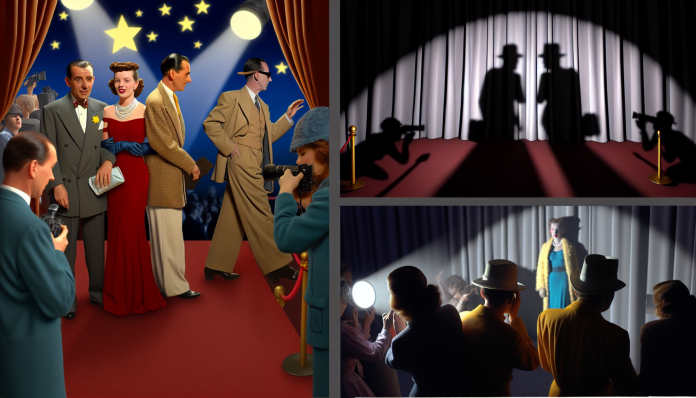Introduction
The glitzy allure of Hollywood’s Golden Age has long fascinated audiences worldwide. However, beneath the shiny facade of glamour and filmmaking brilliance lurked a darker underbelly—one that many sought to illuminate as the “casting couch.” Scandals involving sexual exploitation and manipulation have dotted the history of Hollywood, with figures like Louis B. Mayer and, more controversially, Harvey Weinstein coming to define the transactional sexual relationships that permeated the industry.
Set against the backdrop of a society undergoing immense changes in moral values and sexual attitudes, these scandals reveal how power dynamics in Hollywood were not just leveraged for personal gain but also paralleled broader societal norms surrounding sex and control. As we dive into these historic scandals, we’ll explore how perceptions have shifted over the decades, particularly in our current landscape that demands transparency and accountability.
The Scandal
The term “casting couch” originated in Hollywood in the early 20th century, depicting a troubling practice where aspiring actresses were often pressured to trade sexual favors for roles. In an industry dominated by the whims of powerful studio heads, many young women found themselves navigating treacherous waters where their career aspirations could interweave dangerously with their personal integrity.
Key Figures and Events
One of the most notorious figures associated with this practice was Louis B. Mayer, the head of MGM Studios. Mayer was not just a titan of cinema; his influence extended far beyond the projector screen. He became infamous for his exploitation of young actresses, using his clout to coerce them into compromising situations.
“It’s not that the couch was a mere furniture piece, it was a physical manifesto of the power play—an unspoken agreement that a woman’s success came with strings attached,” reflected Anne Helen Petersen, a cultural critic and author.
Public Reactions
While Hollywood was a bastion of dream-making, the reality behind the scenes painted a different picture. In the 1940s and 50s, public perception of sexual misconduct was shrouded in silence. The few actresses who dared to speak up—like Carole Landis and Marilyn Monroe, who hinted at their uncomfortable experiences—often found themselves ostracized or dismissed. The prevailing mindset was that without a powerful man’s sponsorship, careers might end before they began.
Nevertheless, some opposition began to arise in the form of exposé anecdotes shared in magazines like Confidential and Photoplay. While these weren’t necessarily anti-establishment voices, they indicated a shift in how sexual exploitation was viewed in Hollywood than it had been previously.
Moral and Cultural Analysis
Societal Reaction at the Time
By the mid-20th century, moral standards were influenced heavily by conservative social norms. Sex was often considered taboo, and discussions about sexual harassment largely didn’t exist. Women were largely viewed through the lens of their roles as homemakers or objects of desire. Thus, when scandals broke into public consciousness, they elicited a range of responses, from shock to outright denial.
The consequences for those involved were, in many cases, non-existent. If women spoke out, they often faced backlash or career consequences, while powerful men continued to wield their influence with little to no repercussion. Historical accounts of these incidents often reflect how society was more inclined to rally around powerful men than to consider the claims of women, a pattern that resonates distressingly with modern audiences.
Modern Audience’s Perspective
Compare that to today. In an era where movements like #MeToo and Time’s Up have gained immense traction, the handling of such scandals has shifted dramatically. Today, awareness has burgeoned around issues of consent and sexual harassment, leading to calls for accountability. A modern audience would view these casting couch practices not just as scandalous but as egregious violations of ethical and professional standards.
The harsh consequences faced by figures like Harvey Weinstein highlight this shift. Once a titan of the industry, he is now a symbol of everything wrong with Hollywood’s power dynamic—from his fall from grace to an active criminal trial—emphasizing the changing tides towards demanding justice for survivors.
Conclusion
Reflecting on the casting couch scandals of Hollywood’s Golden Age reveals critical insights into society’s evolving attitudes toward sex, power, and personal freedom. It’s a testament to the profound cultural changes over the decades and emphasizes the necessity for ongoing discourse and reform. As we sift through history’s remnants, we can better understand how far we’ve come and the long road ahead in striving for true equality and respect in all spheres of life.
As you ponder gossamer tales of yore and their impact on contemporary values, consider this: the narratives we tell about our past not only shape our understanding of history but also influence how we interpret and challenge current societal norms. Ultimately, history goes beyond mere dates and events; it serves as our enduring lesson on how power and exploitation intertwine, infusing the cultural fabric we navigate daily.
Thinking critically about these issues is essential. Do we simply accept history as it stands, or are we ready to sculpt a new narrative that champions equity and consent? The choice is indeed ours to shape the future of intimacy and relationships in society.

